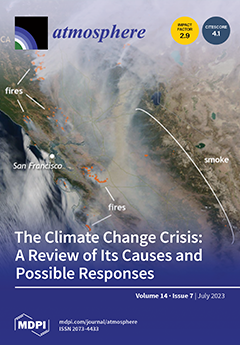Drought has a direct impact on regional agricultural production, ecological environment, and economic development. The northwest region of China is an important agricultural production area, but it is also one of the most serious areas of water shortage due to drought and little
[...] Read more.
Drought has a direct impact on regional agricultural production, ecological environment, and economic development. The northwest region of China is an important agricultural production area, but it is also one of the most serious areas of water shortage due to drought and little rain. It is of great significance to make full use of agricultural resources to clarify the temporal and spatial distribution characteristics of the drought regime in Northwest China. Based on the Standardized Precipitation Evapotranspiration Index (SPEI), this paper used the methods of Mann–Kendall non-parameter trend, mutation test, and Morlet wavelet analysis to explore the drought characteristics in Northwest China from 1961 to 2017. The results showed that the spatial distribution of SPEI on annual and seasonal scales differed slightly in different regions, but from northwest to southeast, the distribution was generally wetter to drier. The drought intensity (
Sij) had a step-like distribution with a range of 1.14–1.98. Based on
Sij analysis, the frequency of drought in Northwest China was moderate, followed by extreme drought, severe drought, and light drought. The inter-annual drought station proportion (
Pj) ranged from 7.4% to 84.1%. A total of 25, 18, 7, and 5 years of pan-regional drought, regional drought, partial region drought, and local drought occurred, respectively, based on
Pj analysis. Moreover, from the whole study period, the regional drought changes tended to cause humidification to different degrees. The results of Morlet wavelet analysis showed that there were multiple time scales of 33–52, 11–19, and 4–7 years of SPEI in the entire time domain, and dry and wet trends occurred. The results of the present research can provide a reference for the efficient utilization of water resources, drought monitoring and early warning, drought prevention, and drought relief in Northwest China.
Full article





